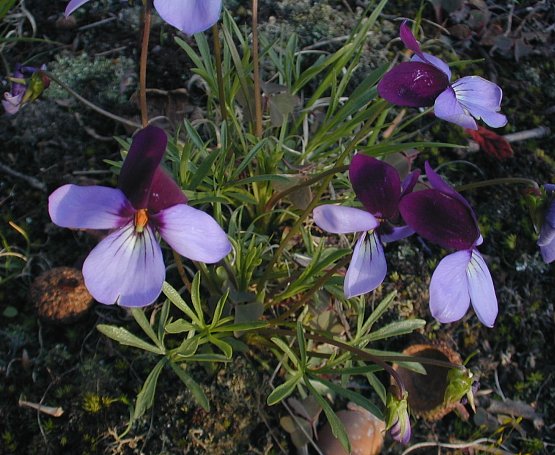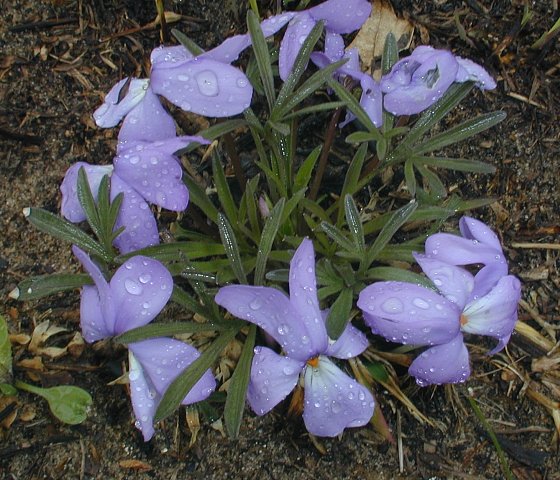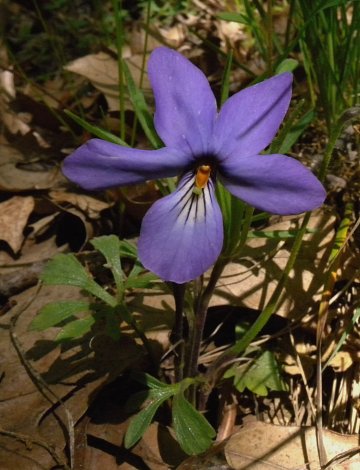Description: This perennial plant is 3-6" tall. The individual leaves and flowering stems emerge directly from the rootstock. Each leaf is deeply divided into 3-5 palmate lobes, while a lobe may be further subdivided into 2-3 smaller lobes. The lobes are usually broader toward their tips than at the base of the leaf, and their tips may have 1 or 2 small teeth. A typical leaf is about 1" long and across (excluding the petiole). The petiole of each leaf is rather long and slender. The slender flowering stems are at least as long as the petioles; they are either green or purple. Each stem curves abruptly downward near the flower. The entire plant is hairless, or nearly so. The flowers have 5 petals and 5 sepals; they are ¾–1½" across. The sepals are green, while the petals are pale blue-violet to dark purple-violet. Usually the petals are the same color, although sometimes the upper two petals are dark purple-violet, while the lower three petals are pale blue-violet. Toward the throat of the flower, the lower petal is white with fine violet lines that function as nectar guides. There are no white hairs near the throat. The stamens are a conspicuous golden yellow.

The blooming
period is mid- to late spring, and this plant may bloom during the
fall. There may be a mild floral scent in some local ecotypes. Unlike
other violets, Birdfoot Violet does not produce cleistogamous flowers.
The coppery seeds can be ejected several inches from the mother plant.
There is a sugary gel on the seeds that attracts ants; these ants often
carry these seeds to their nests. The root system consists of a
tuberous caudex with long coarse roots. Sometimes rhizomes are
produced, forming vegetative offsets.
Cultivation:
The preference is full sun and dry conditions. However, a little shade
and more moisture is tolerated, if the site is well-drained. The soil
should be sandy or rocky to reduce competition from other plants; a
somewhat acid pH is preferred. The greatest danger is crown rot from
poorly drained, heavy soil. This plant is more difficult to grow than
most.

Range &
Habitat:
The native Birdfoot Violet occurs occasionally in northern Illinois and
in
counties along the Mississippi River, but it is uncommon or absent
elsewhere (see Distribution
Map). Habitats include upland areas of black soil prairies,
sand prairies, hill prairies, sandstone glades, cherty slopes, thinly
wooded bluffs, openings in rocky or sandy forests, sandy Black Oak
savannas, and sand dunes near Lake Michigan. This plant is largely
restricted to high quality habitats. Fire is a beneficial management
tool in areas with trees and shrubs.
Faunal Associations:
The flowers attract long-tongued bees, small butterflies, and skippers.
Bee visitors during the spring include bumblebees and Anthophorine
bees. Compared to other violets, the flowers of this species attracts
more butterflies and skippers, which are often held horizontal to the
ground (face up) and easier for such insects to land on. The
caterpillars of various Fritillary butterflies feed on the foliage and
flowers; the caterpillars of Speyeria idalia (Regal
Fritillary) may prefer this violet species over others as a food
source. As noted above, ants are attracted to the sugary gel on the
seeds, and help to distribute them.

Photographic
Location:
The photograph of the plant with bicolored flowers was taken at a
thinly wooded bluff near Kickapoo State Park in Vermilion County,
Illinois. The photograph of the plant with pale
blue-violet flowers was taken at a sandy savanna in Kankakee County,
Illinois. The photograph of the plant with with violet flowers was
taken on a sandy wooded hillside at the Indiana Dunes State Park in NW
Indiana.
Comments:
The photographs show three different color-forms of Birdfoot Violet and
they are all beautiful. This violet can be distinguished from other Viola
spp. (Violets) by its deeply lobed leaves, the large size of
its flowers, and the absence of hairs near the throat of each flower.
The common name refers to the appearance of the leaves.